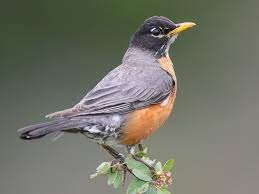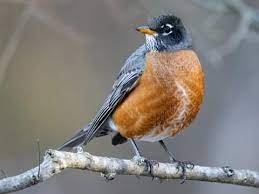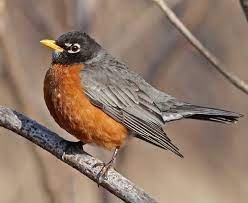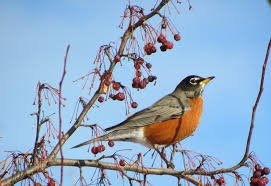“The Great Lake State” is a nickname for Michigan. This is so because the Great Lakes State is home to more than 64,000 linear bodies of water. Despite being only the 11th largest state, it has the 10th highest population. The White-tailed Deer is the state mammal, but what bird represents Michigan?
What is the State Bird of Michigan?

The American Robin (Turdus migratorius), also known as the robin redbreast, was officially designated as Michigan’s state bird in 1931. In reality, this migratory songbird with the infamous “red breast” has chest feathers that range in color from peach to red maroon. “the robin redbreast is the best known and best-loved of all the birds in the state of Michigan,” the bill reads. Connecticut and Wisconsin both claim the American robin (Turdus migratorius) as their official state bird.
Also, know What Do European Robins Eat?
Where is American Robin found?

Locations with people, grass, farms, forests, and berry-bearing trees in the winter. In the summer, you can find them all over the continent, nesting in the mud and branches of trees. In the dry southwest, summers are spent mostly in the mountains among the coniferous forests and only rarely in the well-watered suburbs of the lowlands. During the colder months of the year, flocks congregate near forests with abundant berry-bearing trees and shrubs.
When and why was the State Bird of Michigan declared?

The American robin was chosen as Michigan’s state bird in a recent contest. Some versions of House Concurrent Resolution 30 quote a statement to the effect that “the robin is the best known and best-loved of all the birds in the State of Michigan.” The bird can be found in almost any yard, forest, or park in Michigan. On April 8, 1931, the bird was officially recognized by legislation. Its state bird is the same as that of Connecticut and Wisconsin: the American robin.
The appearance of the State Bird of Michigan

While both sexes of the American robin share the same overall appearance, the female has slightly less vibrant red on her chest and stomach. There is a broken ring around each of the birds’ eyes, and their heads are black or dark grey. These birds typically have black bills with a brownish tint near the base. They are primarily grey on top, with a white tail. This bright and cheery bird is rounded out by its streaked throat and its thin, yellow bill. When winter sets in, they don a much lighter plumage than when summer is in full swing. Breasts of young birds of this species are white and spotted.
The average length of an American robin is 8.5 inches (from beak to tail), but they can reach a maximum size of 11 inches. It has a wing span of 12-16 inches. In the range of 2.3 and 3 ounces, these tiny birds are incredibly light.
The American robin is a solo bird that can be heard chirping and dancing around yards and gardens in suburban areas. A robin’s song is likely to be the first thing you hear in the morning.
Do American Robins migrate?

As long as it’s not the breeding season, the American robin will travel in large groups. In addition to North America, they also frequently travel to Central America. They take annual trips to Florida to escape the harsh winter weather. This bird also frequently spends the winter along the Gulf Coast and in central Mexico. Some people take planes to the west coast.
It’s possible to find them as far north as Canada and Alaska in the spring and summer, but they prefer to mate and have offspring when it’s warmer outside. Its breeding season is from April to July. The breeding process dampens their generally upbeat demeanor because of their aggressive territorial defense.
Do American Robins congregate?

The American robin often congregates with other birds for brief periods. Many robins travel together as a flock every year on their annual winter migration south. With each other’s protection in mind, they fly great distances together. When people travel in large groups, they are less likely to be attacked by predators.
They disperse into smaller groups once they reach their destination. Every single bird builds its own unique nest. They can spend a cozy winter here in their nest. During the warmer months, they return to their year-round residence and construct a nest there. Nest elevation ranges from 4.91 to 14.89 feet. They typically conceal it in thick underbrush or a fork between two trees.
A single American Robin can have three successful broods in a single year. In reality, though, only about 60% of nests manage to hatch young. By November, only a quarter of the young birds will still be alive. From that point on, approximately 50% of surviving robins each year will do so. A single robin can live up to 14 years, but the entire population typically dies off and starts over every six years.
What do American Robins do in winter?

Despite their reputation as heralds of spring, many American Robins spend the entire winter within their breeding range. However, you won’t see them as often because they prefer to roost in trees rather than in your backyard. Depending on the weather and other factors, the number of robins in the range’s northern regions can change from year to year.
Also, know Do Starlings Migrate?
When winter comes around, robins load up on fruit. Honeysuckle berries are a popular food source, but when they’re all they eat, the animals can become delirious.
In the winter, robin roosts can be extremely large, with up to a quarter of a million birds congregating there. In the warm months of the year, females rest at their nests while males congregate on roosts. You can tell a young robin has reached the maturity when it starts hanging out with the adult males. After adult females are done nesting, only then do they venture to the roosts.
American Robins Diet

Robins’ diets change throughout the day, with more earthworms and fewer fruits and vegetables in the morning. The robin’s susceptibility to pesticide poisoning is heightened by the fact that it typically feeds on lawns, making it a useful indicator of chemical pollution.
Facts about American Robins
- A 13-year-and-eleven-month-old American Robin was the longest-lived bird of its species.
- In the colder months, a robin’s diet shifts to include more fruits and berries. With its high-calorie density, fruit is a great food choice for these birds during the colder months.
- Fall is when robins shift their diet from including worms and insects as a supplement to eating almost exclusively fruits and berries, as the cooler weather and shorter days encourage them to do so.
- During this time of year, it can be difficult, if not impossible, for robins to find food because insects, worms, and other bugs are less active above ground.





